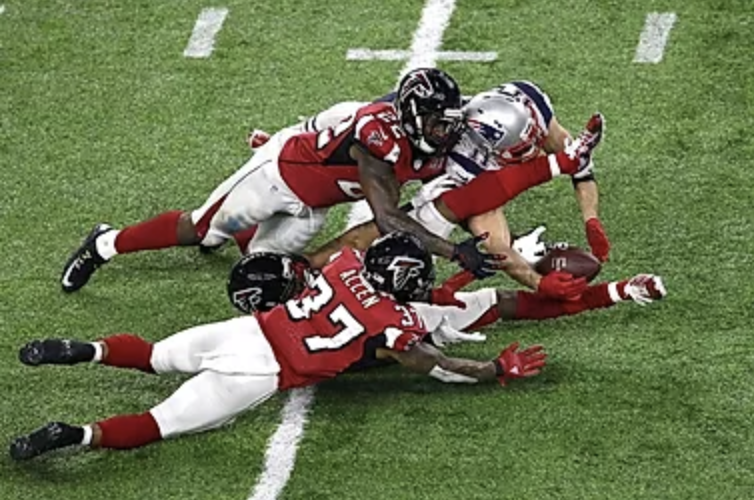Never-Give-Up Patriots a Model to Struggling SAT and ACT Students
Last night’s Super Bowl blew me away. Lady Gaga alone was fantastic, but having edited down my thoughts on how much I liked her performance (let me just say I loved her guttural yell to the crowd before her last song: ‘Come on! Let’s go! This is the Super Bowl! This is what Champions are made of!’ So respectful and aware, honoring the athletes for whom she was performing, when most artists treat their cameo as being purely about their own music),
But this post is not about Gaga.
It’s about the Patriots – whose focus and persistence in the face of failures could not have been a more inspiring and instructive example for my students, who are fighting in the Junior Spring study trenches to raise their scores.
Down 21-3 at halftime, the Patriots appeared destined to lose. Their receivers dropped passes. Quarterback Tom Brady threw an interception. When their kicker clanged an extra point point jarringly off the upright, it seemed a symbol for how the night would end.
Many of my students are in this stage: they have been studying for the SAT or ACT for months and are surprised at how much work they are doing. Meanwhile, their scores have barely budged.
It’s at this point each year that I struggle to convince them how talented they are,how well they will ultimately do, and how much their success will depend on cultivating an attitude of persistence – what Stanford’s Carol Dweck calls a “growth mindset.”
As I watched the game, I studied Brady and coach Bill Belichick’s body language.
Their posture never weakened; a “woe is me” expression never crossed their faces. Instead I saw determination: to give it their best on the next play, and then see what happens.
Harry studied with me last year and started at a 20 on his ACT. A very bright guy, he’s the only student I’ve had who, every session, had a new idea for my tutoring business which would radically grow and improve it.
Harry wanted to beat his older sister’s score of a 31, but after six months of hard work, he still hadn’t gotten above a 27. Test after test showed 25, 27, 23, 26, etc.
Upon scoring his second straight 27 in mid-May, Harry’s mom sent me the score report over email:
“I haven’t shared this with Harry,” she wrote. “I feel bad for him. What should we do?”
I have traveled this road so many times with students and their parents: raising ACT and SAT scores is harder than you want it to be. You push and struggle,and push and struggle against ceilings that seem to hang over your score – until you break through them.
If you have not broken through, you simply have not done the work you need to, yet.
There are no magical solutions. It can take months. Top New York City tutoring agencies like Advantage Testing and Private Prep reportedly advise students to expect a one-year and 9-month time investment, respectively.
Students think their job, at this point, is to get problems correct, but it’s not: it’s to cultivate the Patriots’ persistence. “The secret of life,” Paolo Coelho wrote in The Alchemist, “is to fall seven times and to get up eight times.”
Harry and his parents listened to my encouragements – I could see his potential to score well into the 30s, if he only kept working at it.
Six weeks later, he sent me this text:
Harry had raised his score by 12 points in the end, equivalent to 400 points on the 1600-scale SAT.
I have seen students lose their courage to keep failing, their persistence to keep going, their belief that it will all work out – fantastically, in fact – in the end.
Sometimes they decide to stop working with me, and it hurts so much for me to recognize their potential as they stop prematurely – to miss the chance to guide them through their breakthrough.
The breakthroughs are the best.
“I hope your sitting down!!!!” Alexandra once wrote me before sending me a screenshot of her 31 last June. Alexandra does not send texts with exclamation points.
23, 22, 24, 24, and 29 had been her timed mock test scores before knocking it out of the park with a 31 on her final ACT. It felt like Julian Edelman’s fourth quarter catch last night – finally she had caught a break – and she had earned that break!
She was invited to play a Division I sport at a college where the average ACT is a 31.
Lydia once called me to have me log into her account myself so I could verify that the 29 she had scored in June was actually real. She was astounded.
Before that, over many months, she had scored 21, 22, 24, 24, 22, 25, 24, 22, and 25 on proctored practice tests. She was starting to think she could apply to only test-optional schools.
Not until the very end, after scoring a 27 on her last practice test, could she believe what I had been telling her all along: you can score a 30! You can scorehigher than a 30!
Her 29 last June was close, a score hard for her to imagine when she had logged so many low- and mid-20s scores in the months before.
(I must say that Lydia had not yet mastered the Patriots-esque response to frustrations. Despite getting down on herself, though, she persisted, and most importantly, she could not believe how well she did in the end.)
I asked Lydia what advice she would give juniors now.
“I think it’s a really long process, and it’s really hard,” she answered. “Make sure that you’re consistently doing work throughout. Because you can’t do well at the last minute. It takes time to build the skills to do it. Be patient with yourself, and just know that your score can always go up, and if it isn’t, you’re probably just doing something wrong, and you just find a way to do it.”
Where had Lydia learned to talk like this? This was beautiful.
Your attitude of persistence in the face of hardship – that is what it’s all about.
“Funny thing,” Patriots’ offensive coordinator Josh McDaniels said after the Super Bowl. “When we came out after halftime, “Bill [Belichick] said to me, ‘We’ll be okay. Our guys believe. They will fight their ass off.’
“I think when you’ve got Tommy [Brady], you feel like there’s never going to be any kind of panic in him, so there’s never going to be any kind of panic in us.”
Defensive end Chris Long summed it up: “That’s the thing—nothing different was really said at halftime. It was all normal.”
_______
* The names of my students have been changed



